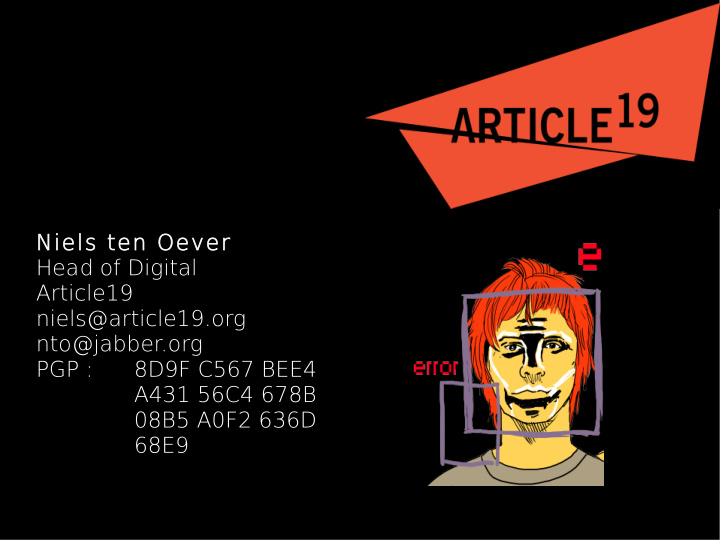



Niels ten Oever Head of Digital Article19 niels@article19.org nto@jabber.org PGP : 8D9F C567 BEE4 A431 56C4 678B 08B5 A0F2 636D 68E9
Overview ● What is systems security ● Adding Internet to the mix ● Infrastructure hacking ● Companies and governments ● Other infrastructure ● Cyberdefense and cyber offense
What is systems security ● Security is the state of being free from danger or threat ● Systems security is the practice of controlling which processes can be executed on a specific system, and by whom. It limits possibilities. ● Control, system transparency, autonomy and sovereignty ● Software, hardware & users.
Adding Internet to the mix ● What allows the Internet to be open and innovative is also what poses risks ● We're using the same infrastructure to do many different things at the same time. ● Who is responsible for what?
Adding Internet to the mix (RFC1281) The Internet is a voluntary network, operated on a ● collaborative basis Each participating network takes responsibility for its own ● operation. Service providers, private network operators, users and vendors all cooperate to keep the system functioning. Often on a best effort basis (depending on contracts) It is important to recognize that the voluntary nature of the ● Internet system is both its strength and, perhaps, its most fragile aspect.
Adding Internet to the mix (issues) ● Privacy and security are important and recognized parts of the network on a protocol and standards basis. ● But it's only as secure as its implementation ● There are some issues (examples): ● Confidentiality (heartbleed / SSL) ● Integrity (packet injections / QUANTUM) ● Availability (DDoS) ● Leaky servers (passwords, ports, code) ● Users ●
SCADA ● Supervisory control and data acquisition ● T ype of industrial control system ● Bridges, power plants, water filtration plants, waste systems, electricity grids, gas and oil pipelines and refineries ● 99% of these systems are connected to the Internet. Why? ● Unintentionally because of bad firewall settings ● Because with the Internet, you don't need to build your own infrastructure
SCADA II ● The level of security is generally very low ● Many of the systems that were tested can be exploited with standard metasploit package ● Running on old machines. A lot still run Windows 2000, Windows 95, Windows XP (upgrade is expensive because of proprietary software (which has serious security implications) ● No hardware control (people plug in their own devices, use standard computers) ● Many of these systems are operated via webinterfaces
SCADA III ● Vulnerabilities are generally found by security researchers, also known as hackers ● Vulnerabilities are shared with big providers: – Siemens (by far largest S7 1200 PLC) – Emerson – Allen-Bradley – Rockwell Automation – Schneider Electric – General Electric
Companies & governments ● Biggest attack to SCADA systems up to now was Stuxnet – Worm & Rootkit. Spread via USB device and via network. Country Infected computers – Iran 58.85% – Indonesia 18.22% – India 8.31% – Azerbaijan 2.57% – United States 1.56% – Pakistan 1.28% – Others 9.2% ●
Companies & governments ● T echnology democratizes, once it's out there it can be use by, and against, everyone. It's not a precision tool. ● Malware is copied and recycled. ● Governments work together with companies because they don't have the in-house capacity. Companies do not have the same accountability levels ● Hacking team, Blue Coat, Gamma International, T rovicor
Other infrastructure ● Border Gateway Protocol ● Domain Name System ● Undersea cables ● Standards ● Providers (Google, Apple, Cisco, etc)
Cyber defense & offense ● T echnology democratizes, once it's out there, you cannot get it back ● Defense is still poor, increased capacity is needed. For instance institutionalized penetration tests of infrastructure ● Attribution is a very big problem and risk > Sony ● CIRT s and CSIRT s can help, but this is reactive (the house is already on fire) ● These attacks always impact civilians and the Internet
Cyberweapons do not solve cybersecurity improved security practices do
Recommend
More recommend